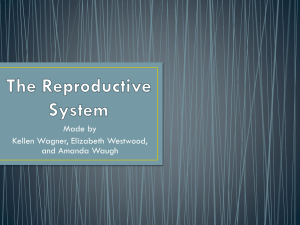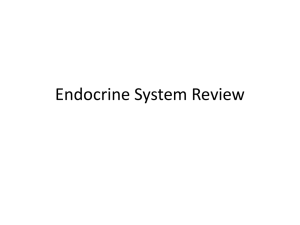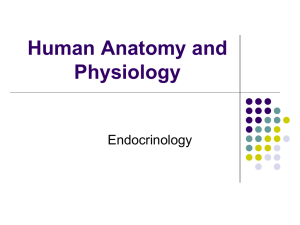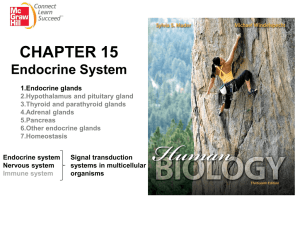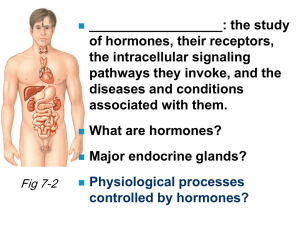16 The Endocrine System Lecture Outline
advertisement
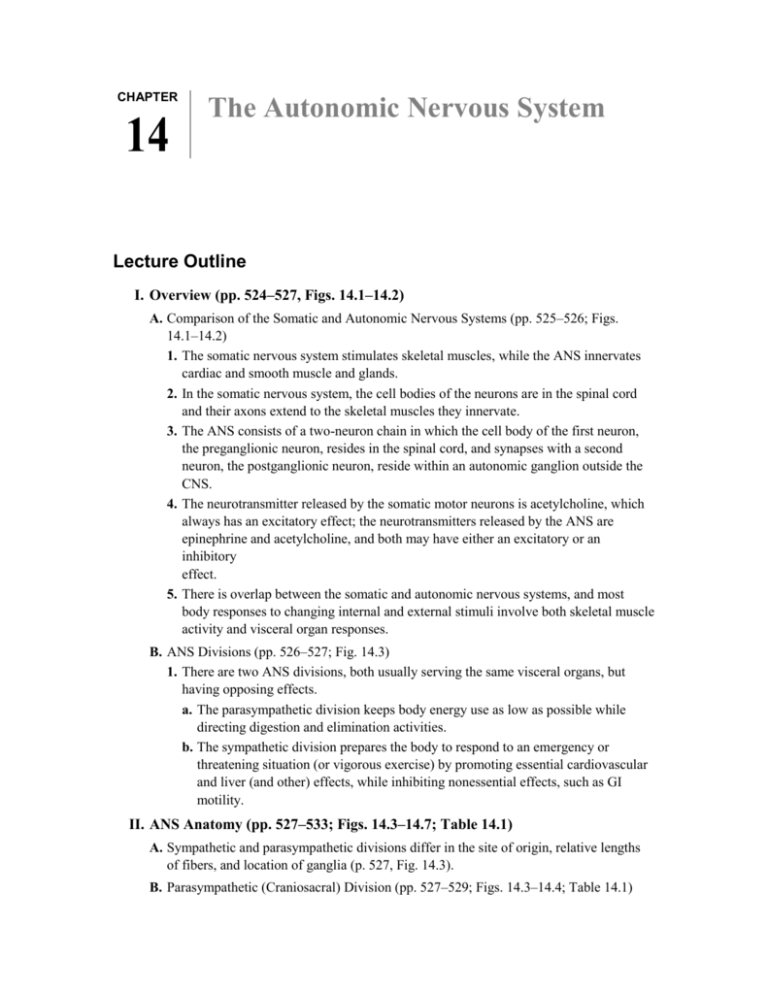
CHAPTER 14 The Autonomic Nervous System Lecture Outline I. Overview (pp. 524–527, Figs. 14.1–14.2) A. Comparison of the Somatic and Autonomic Nervous Systems (pp. 525–526; Figs. 14.1–14.2) 1. The somatic nervous system stimulates skeletal muscles, while the ANS innervates cardiac and smooth muscle and glands. 2. In the somatic nervous system, the cell bodies of the neurons are in the spinal cord and their axons extend to the skeletal muscles they innervate. 3. The ANS consists of a two-neuron chain in which the cell body of the first neuron, the preganglionic neuron, resides in the spinal cord, and synapses with a second neuron, the postganglionic neuron, reside within an autonomic ganglion outside the CNS. 4. The neurotransmitter released by the somatic motor neurons is acetylcholine, which always has an excitatory effect; the neurotransmitters released by the ANS are epinephrine and acetylcholine, and both may have either an excitatory or an inhibitory effect. 5. There is overlap between the somatic and autonomic nervous systems, and most body responses to changing internal and external stimuli involve both skeletal muscle activity and visceral organ responses. B. ANS Divisions (pp. 526–527; Fig. 14.3) 1. There are two ANS divisions, both usually serving the same visceral organs, but having opposing effects. a. The parasympathetic division keeps body energy use as low as possible while directing digestion and elimination activities. b. The sympathetic division prepares the body to respond to an emergency or threatening situation (or vigorous exercise) by promoting essential cardiovascular and liver (and other) effects, while inhibiting nonessential effects, such as GI motility. II. ANS Anatomy (pp. 527–533; Figs. 14.3–14.7; Table 14.1) A. Sympathetic and parasympathetic divisions differ in the site of origin, relative lengths of fibers, and location of ganglia (p. 527, Fig. 14.3). B. Parasympathetic (Craniosacral) Division (pp. 527–529; Figs. 14.3–14.4; Table 14.1) 1. The preganglionic axons extend from the CNS nearly all the way to the structures to be innervated, where they synapse with postganglionic neurons in the terminal ganglia. 2. The cranial outflow consists of preganglionic fibers that run in the oculomotor, facial, glossopharyngeal, and vagus cranial nerves. 3. The rest of the large intestine and the pelvic organs are served by the sacral outflow, which arises from neurons located in the lateral gray matter of spinal cord segments S2–S4. C. Sympathetic (Thoracolumbar) Division (pp. 529–533; Figs. 14.3, 14.5–14.6; Table 14.1) 1. The sympathetic division supplies the visceral organs in the internal body cavities but also all visceral structures in the somatic part of the body. 2. When synapses are made in chain ganglia, the postganglionic axons enter the ventral (or dorsal) ramus of the adjoining spinal nerves by way of communicating branches called gray rami communicantes. 3. The preganglionic fibers from T5 down synapse in collateral ganglia; thus these fibers enter and leave the sympathetic chains without synapsing. 4. Some fibers of the thoracic splanchnic nerves terminate by synapsing with the hormone-producing medullary cells of the adrenal cortex. D. The visceral sensory neurons are the first link in autonomic reflexes, sending information concerning chemical changes, stretch, and irritation of the viscera (p. 533; Fig. 14.7). III. ANS Physiology (pp. 533–539; Fig. 14.8; Tables 14.2–14.4) A. Neurotransmitters and Receptors (pp. 533–535; Table 14.2) 1. Cholinergic receptors, such as nicotinic and muscarinic receptors, bind acetylcholine. 2. Adrenergic receptors alpha and beta bind to epinephrine. B. Knowing the locations of the cholinergic and adrenergic receptor subtypes allows specific drugs to be prescribed to obtain desired inhibitory or stimulatory effects on target organs (p. 535; Table 14.3). C. Interactions of the Autonomic Divisions (pp. 535–537; Table 14.4) 1. Most visceral organs receive dual innervation by both ANS divisions, allowing for a dynamic antagonism to exist between the divisions and precise control of visceral activity. a. The sympathetic division increases heart rate, dilates airways, and inhibits digestion and elimination while the body is under stress. b. After the stress has passed, the parasympathetic division returns heart rate and airway diameter to normal and allows digestion and elimination to resume. 2. Sympathetic tone throughout the vascular system allows the firing rate of sympathetic neurons to control the diameter of blood vessels, regulating systemic blood pressure. 3. Parasympathetic tone is usually dominant in the heart, digestive system, and urinary tracts, maintaining normal homeostatic levels of function unless overridden by the sympathetic system during stress. 4. Sympathetic and parasympathetic divisions show a cooperative effect in the genitalia during sexual excitement and release. 5. The sympathetic system has a unique role in control of the adrenal medulla, sweat glands, arrector pili muscles of the skin, the kidneys, and most blood vessels. 6. The parasympathetic division exerts short-lived, localized control over its effectors, whereas effects of the sympathetic division are persistent and widespread. D. Control of Autonomic Functioning (pp. 538–539, Fig. 14.8) 1. The brain stem appears to exert the most direct influence over autonomic functions. 2. The hypothalamus is the main integration center for the autonomic nervous system. 3. Cortical or voluntary control of the autonomic nervous system may be possible. 4. Biofeedback training may enable a person to alter some involuntary functions. IV. Homeostatic Imbalances of the ANS (p. 539) A. Most autonomic disorders reflect exaggerated or deficient control of smooth muscle (p. 539). 1. Hypertension, or high blood pressure, may result from an overactive sympathetic vasoconstrictor response due to continuous high levels of stress. 2. Raynaud’s disease is characterized by intermittent attacks causing the skin of the fingers and the toes to become pale, then cyanotic and painful. 3. Autonomic dysreflexia is a life-threatening condition involving uncontrolled activation of both somatic and autonomic motor neurons. CHAPTER 16 The Endocrine System Lecture Outline I. The Endocrine System: An Overview (pp. 592–593; Fig. 16.1) A. Endocrinology is the scientific study of hormones and the endocrine organs (p. 592; Fig. 16.1). 1. Hormones are chemical messengers that are released to the blood and elicit target cell effects after a period of a few seconds to several days. 2. Hormone targets include most cells of the body and regulate reproduction, growth and development, electrolyte, water, and nutrient balance, cellular metabolism and energy balance, and mobilization of body defenses. 3. Endocrine glands have no ducts and release hormones through diffusion. 4. Endocrine glands include the pituitary, thyroid, parathyroid, adrenal, and pineal glands. 5. Several organs, such as the pancreas, gonads (testes and ovaries), and placenta, as well as adipose tissue, thymus, intestine, stomach, kidneys, and heart contain endocrine tissue. B. Autocrines are local chemical messengers that act on the same cells that secrete them, while paracrines are local chemical messengers that act on neighboring cells, rather than the cells releasing them (pp. 592–593). II. Hormones (pp. 593–598; Figs. 16.2–16.4) A. The Chemistry of Hormones (p. 593) 1. Most hormones are amino acid based, but gonadal and adrenocortical hormones are steroids, derived from cholesterol. 2. Eicosanoids, which include leukotrienes and prostaglandins, derive from arachidonic acid. B. Mechanisms of Hormone Action (pp. 593–595; Figs. 16.2–16.3) 1. Cells that have receptors for a given hormone are called target cells. 2. Hormones typically produce changes in membrane permeability or potential, stimulate synthesis of proteins or regulatory molecules, activate or deactivate enzymes, induce secretory activity, or stimulate mitosis. 3. Water-soluble hormones (all amino acid–based hormones except thyroid hormone) exert their effects through an intracellular second messenger that is activated when a hormone binds to a membrane receptor. 4. Lipid-soluble hormones (steroids and thyroid hormone) diffuse into the cell, where they bind to intracellular receptors, migrate to the nucleus, and activate specific genes. 5. Second-messenger systems, signaled by most amino acid–based hormones, cause the generation of an intracellular second messenger when a hormone binds to a membrane receptor. a. The cyclic AMP signaling mechanism, or the PIP2-calcium signaling mechanism, involves the G protein–mediated activation of enzymes that results in the activation of protein kinases. 6. Direct gene activation occurs when a lipid-soluble hormone or thyroid hormone binds to an intracellular receptor, which activates a specific region of DNA, causing the production of mRNA and initiation of protein synthesis. C. Target Cell Specificity (pp. 595–596) 1. Cells must have specific membrane or intracellular receptors to which hormones can bind. 2. Target cell response depends on three factors: blood levels of the hormone, relative numbers of target cell receptors, and affinity of the receptor for the hormone. 3. Target cells can change their sensitivity to a hormone by changing the number of receptors. a. Persistently low levels of hormone can cause a cell to up-regulate, increasing the number of receptors, but persistently high levels of hormone can cause a cell to down-regulate, decreasing the number of hormone receptors. D. Control of Hormone Release (pp. 596–597; Fig. 16.4) 1. Most hormone synthesis and release is regulated through negative feedback mechanisms. 2. Endocrine gland stimuli may be humoral, neural, or hormonal. a. Critical ions or nutrients that act as stimuli controlling the secretion of hormones are humoral stimuli. b. If nerve fibers stimulate hormone release, then the stimulus for release is neural. c. If the secretion of a hormone is in response to hormones produced by other endocrine glands, it follows a hormonal pattern of secretion. 3. Nervous system modulation allows hormone secretion to be modified by hormonal, humoral, and neural stimuli in response to changing body needs. E. Half-Life, Onset, and Duration of Hormone Activity (p. 598) 1. The concentration of a hormone reflects its rate of release and the rate of inactivation and removal from the body. 2. The half-life of a hormone is the duration of time a hormone remains in the blood and is shortest for water-soluble hormones. 3. Target organ response and duration of response vary widely among hormones. F. Interaction of Hormones at Target Cells (p. 598) 1. Permissiveness occurs when one hormone cannot exert its full effect without another hormone being present. 2. Synergism occurs when more than one hormone produces the same effects in a target cell, and their combined effects are amplified. 3. Antagonism occurs when one hormone opposes the action of another hormone. III. The Pituitary Gland and Hypothalamus (pp. 598–606; Figs. 16.5–16.8; Table 16.1) A. The pituitary gland is situated in the sella turcica of the skull, and is connected to the brain via the infundibulum (p. 598; Fig. 16.5). B. The pituitary has two lobes: the posterior pituitary, or neurohypophysis, which is neural in origin, and the anterior pituitary, or adenohypophysis, which is glandular in origin (pp. 598–599; Fig. 16.5). 1. The hypothalamic-hypophyseal tract is a neural connection between the hypothalamus and the posterior pituitary that extends through the infundibulum. 2. The hypothalamic-hypophyseal portal system is a vascular connection between the hypothalamus and the anterior pituitary that extends through the infundibulum. C. The Posterior Pituitary and Hypothalamic Hormones (pp. 599–601; Table 16.1) 1. The posterior pituitary produces two neurohormones: oxytocin, which promotes uterine contraction and milk ejection, and antidiuretic hormone (ADH), which prevents wide swings in water balance. D. Anterior Pituitary Hormones (pp. 601–606; Figs. 16.5–16.8; Table 16.1) 1. The anterior pituitary produces six hormones, four of which are tropic hormones that regulate secretion of other hormones, as well as a prohormone. a. Pro-opiomelanocortin (POMC) is a prohormone that can be split into adrenocorticotropic hormone, two natural opiates, and melanocyte-stimulating hormone. b. Growth hormone acts on target cells in the liver, skeletal muscle, bone, and other tissues to cause the production of insulin-like growth factors (IGFs). c. Thyroid-stimulating hormone (TSH) promotes secretion of the thyroid gland. d. Adrenocorticotropic hormone (ACTH) promotes release of corticosteroid hormones from the adrenal cortex. e. Gonadotropins FSH (follicle-stimulating hormone) and LH (luteinizing hormone) regulate function of the gonads. f. Prolactin stimulates the gonads and promotes milk production in humans. IV. The Thyroid Gland (pp. 606–610; Figs. 16.9–16.11; Table 16.2) A. The thyroid gland consists of hollow follicles with follicular cells that produce thyroglobulin and parafollicular cells that produce calcitonin (pp. 606–607; Fig. 16.2). B. Thyroid hormone consists of two amine hormones, thyroxine (T4) and triiodothyronine (T3), that act on all body cells to increase basal metabolic rate and body heat production (pp. 607–610; Figs. 16.10–16.11; Table 16.2). 1. The thyroid can store a three to four months’ supply of thyroid hormone. 2. Synthesis of thyroid hormone involves several steps: a. Thyroglobulin is synthesized and secreted to the follicle lumen. b. Iodide is trapped and oxidized to iodine, which is then attached to the tyrosine portion of thyroglobulin. c. Iodinated tyrosines are linked to form T3 and T4. d. To secrete T3 and T4, thyroglobulin colloid is transported into follicular cells, where the thyroglobulin is removed, allowing the hormone to diffuse into the blood stream. C. Calcitonin, secreted by C cells of the thyroid, is a peptide hormone that lowers blood calcium by inhibiting osteoclast activity, stimulating Ca++ uptake and incorporation of Ca++ into the bone matrix (p. 610). V. The Parathyroid Glands (pp. 610–611; Figs. 16.12–16.13) A. The parathyroid glands are located on the posterior aspect of the thyroid (p. 610). B. Parathyroids secrete parathyroid hormone, or parathormone, which causes osteoclasts to break down bone, increases absorption of Ca++ in the kidneys, and activates vitamin D, which aids in the absorption of calcium from food (pp. 610–611; Figs. 16.12–16.13). VI. The Adrenal (Suprarenal) Glands (pp. 611–616; Figs. 16.14–16.17; Table 16.3) A. The adrenal glands, or suprarenal glands, consist of two regions: an inner adrenal medulla and an outer adrenal cortex (p. 611; Fig. 16.14). B. The adrenal cortex produces corticosteroids from three distinct regions: the zona glomerulosa produces minerocorticoids, the zona fasciculate produces glucocorticoids, and the zona reticularis produces sex steroids (pp. 612–615; Figs. 16.14–16.15; Table 16.3). 1. Mineralocorticoids, mostly aldosterone, are essential to regulation of electrolyte concentrations of extracellular fluids, raising plasma Na+ and lowering plasma K+. a. Aldosterone secretion is regulated by the renin-angiotensin-aldosterone mechanism, fluctuating blood concentrations of sodium and potassium ions and secretion of ACTH. 2. Glucocorticoids are released in response to stress through the action of ACTH and primarily cause gluconeogenesis, as well as use of fats and amino acid by body cells. 3. Gonadocorticoids are mostly weak androgens, which are converted to testosterone and estrogens in the tissue cells. C. The adrenal medulla contains medullary chromaffin cells that synthesize catecholamines epinephrine and norepinephrine (pp. 615–616; Figs. 16.14, 16.17; Table 16.3). 1. About 80% of the hormone stored is epinephrine, and 20% norepinephrine. 2. Adrenal catecholamines produce brief stress-mediated responses. VII. The Pineal Gland (pp. 617–618) A. The only major secretory product of the pineal gland is melatonin, a hormone derived from serotonin, in a diurnal cycle (p. 617). B. The pineal gland indirectly receives input from the visual pathways in order to determine the timing of day and night (pp. 617–618). VIII. Other Endocrine Glands and Tissues (pp. 618–623; Figs. 16.18–16.19; Tables 16.4–16.5) A. The pancreas is a mixed gland that contains both endocrine and exocrine gland cells (pp. 618–620; Figs. 16.18–16.19). 1. Scattered among the exocrine cells are pancreatic islets that have two major populations of hormone-producing cells: cells that produce glucagon, and cells that produce insulin. 2. Glucagon targets the liver where it promotes glycogenolysis, gluconeogenesis, and release of glucose to the blood (p. 618, Fig. 16.19). 3. Insulin lowers blood glucose levels by enhancing membrane transport of glucose into body cells and inhibits glucose production through glycogen breakdown or conversion of amino acids or fats to glucose (pp. 618–620, Fig. 16.19, Table 16.4). B. The Gonads and Placenta (pp. 620–621) 1. The ovaries produce estrogens and progesterone. 2. The testes produce testosterone. 3. The placenta secretes estrogens, progesterone, and human chorionic gonadotropin, which act on the uterus to influence pregnancy. CHAPTER 17 Blood Lecture Outline I. Overview: Blood Composition and Functions (pp. 632–633; Fig. 17.1) A. Components (p. 632; Fig. 17.1) 1. Blood is a specialized connective tissue consisting of living cells, called formed elements, suspended in a nonliving fluid matrix, blood plasma. 2. Blood that has been centrifuged separates into three layers: erythrocytes, the buffy coat, and plasma. 3. The blood hematocrit represents the percentage of erythrocytes in whole blood. B. Physical Characteristics and Volume (p. 632) 1. Blood is a slightly basic (pH = 7.35–7.45) fluid that has a higher density and viscosity than water, due to the presence of formed elements. 2. Normal blood volume in males is 5–6 liters, and 4–5 liters for females. C. Functions (pp. 632–633) 1. Blood is the medium for delivery of oxygen and nutrients, removal of metabolic wastes to elimination sites, and distribution of hormones. 2. Blood aids in regulating body temperature, body fluid pH, and fluid volume within fluid compartments. 3. Blood protects against excessive blood loss through the clotting mechanism and from infection through the immune system. II. Blood Plasma (p. 633; Table 17.1) A. Blood plasma consists of mostly water (90%) and solutes including nutrients, gases, hormones, wastes, products of cell activity, ions, and proteins (p. 633; Table 17.1). B. Plasma proteins account for 8% of plasma solutes (p. 633). 1. Albumin constitutes roughly 60% of plasma proteins and functions as a carrier, a pH buffer, and an osmoregulating protein. III. Formed Elements (pp. 634–646; Figs. 17.2–17.12; Table 17.2) A. Erythrocytes (Red Blood Cells) (pp. 634–640; Figs. 17.2–17.8; Table 17.2) 1. Erythrocytes, or red blood cells, are small cells that are biconcave in shape, lack nuclei and most organelles, and contain mostly hemoglobin. a. The size and shape of erythrocytes provide a larger surface-to-volume ratio for gas exchange. b. The lack of organelles and anaerobic ATP synthesis means that erythrocytes do not consume any oxygen they carry. 2. Erythrocytes function to transport respiratory gases in the blood on hemoglobin. a. The normal range for hemoglobin in the blood is 13–18 g/100 ml. 3. Hemoglobin is a protein consisting of four polypeptide chains, globin proteins, each with a ringlike heme. a. Each heme contains an atom of iron that serves as the binding site for a molecule of oxygen. b. Oxygen diffuses into the blood in the lungs and binds to hemoglobin, forming bright red oxyhemoglobin. c. At body tissues, oxygen detaches from iron, forming dark red deoxyhemoglobin. d. About 20% of the carbon dioxide carried in the blood is bound to amino acids on the globins, forming carbaminohemoglobin. 4. Production of Erythrocytes a. Hematopoiesis, or blood cell formation, occurs in the red bone marrow. b. All blood cells form from a common hematopoietic stem cell, the hemocytoblast. c. Erythropoiesis, the formation of erythrocytes, begins when a myeloid stem cell is transformed to a proerythroblast, which progresses through several successive stages. d. During the first two phases of development, hemoglobin is synthesized, and iron accumulates. After accumulating all its hemoglobin, the reticulocyte (immature erythrocyte) ejects most organelles, the nucleus degenerates, and the cell assumes its biconcave shape. e. The hematopoietic process takes about 15 days, at which time the reticulocyte enters the bloodstream, where it becomes a fully mature, oxygen-carrying cell within two days. 5. Erythrocyte production is controlled by the hormone erythropoietin (EPO), produced mostly by the kidneys when certain kidney cells become hypoxic. a. Erythropoietin production is triggered by excessive loss of RBCs or reduced availability of oxygen. 6. Dietary requirements for erythrocyte formation include iron, vitamin B12, and folic acid, as well as proteins, lipids, and carbohydrates. 7. Blood cells have a life span of 100–120 days due to the lack of nuclei and organelles. 8. Destruction of dead or dying blood cells is accomplished by macrophages in the spleen, which split the heme from the globin, break globins down to amino acids, bind iron as hemosiderin or ferritin, and convert the remainder of the heme to bilirubin, to be eliminated by the liver. 9. Erythrocyte Disorders a. Anemias are characterized by a deficiency in RBCs that may originate from several causes: i. Hemorrhagic anemia resulting from excessive blood loss. ii. Iron-deficiency, pernicious, or renal anemia resulting from nutritional deficiency in either iron or vitamin B12, or a lack of EPO, which leads to underproduction of erythrocytes. iii. Hemolytic anemias in which erythrocytes are prematurely destroyed. iv. Thalassemias, characterized by an abnormality in one or more globin chains that compromises the oxygen-carrying ability of RBCs. v. Sickle-cell anemia, in which hemoglobin changes shape when oxygen levels are low, causing cells to rupture easily and block small blood vessels. b. Polycythemia is characterized by an excess of RBCs due to oxygen deficiency or disease, which may increase blood viscosity, causing poor blood flow and oxygen delivery.


